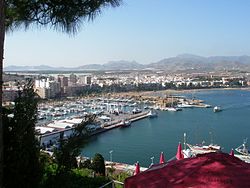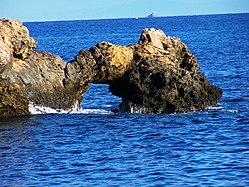| Murcia region | |
 | |
Location .svg/250px-Region_de_Murcia_in_Spain_(including_Canarias).svg.png) | |
Coat of arms and flag | |
| State | Spain |
|---|---|
| Capital | Murcia |
| Surface | 11,313 km² |
| Inhabitants | 1.478.509 (2018) |
| Tourism site | |
| Institutional website | |
Murcia region is one of the seventeen autonomous communities of the Spain, located in the eastern part of the country.
To know
Tourism is centered on the coast which has many virgin stretches, many of which are difficult to access. Many of these coasts are protected natural areas established with the aim of curbing the urbanization that has spread over the remaining Mediterranean coast of Spain to the detriment of the natural environment. On the border with the Alicante province extends the saltwater lagoon of the Mar Menor, the largest in Spain whose waters have a higher temperature than that of the sea. Inside the lagoon there are five islets of volcanic origin. These characteristics make the Mar Menor an important tourist destination. Right on the long sandbar that separates the lagoon from the open sea, in the second half of the twentieth century, a very popular holiday center was built La Manga del Mar Menor.
The centers of Caravaca de la Cruz, Cartagena, Lorca is Murcia present a significant artistic heritage.
Murcia is one of the largest producers Europeans of fruit, vegetables and flowers. The municipalities of Jumilla, Bullas and Yecla also boast extensive vineyards from which wines with a controlled designation of origin are obtained. Industries are concentrated in Cartagena where there are petrochemical and electricity production plants.
Territories and tourist destinations
- Inland
- Coastal Region - Known as the Costa Cálida, the Murcia coast enjoys an extremely sunny climate.
Urban centers
Inland
- Murcia - The regional capital is famous for its historic center gathered around the cathedral with its ornate Baroque facade and for the folk festivals that take place there in spring (Fiestas de Primavera).
- Caravaca de la Cruz - One of the ten holy cities of the Catholic Church that obtained from Pope John Paul II the perpetual privilege of celebrating the jubilee every 7 years. In addition to presenting an interesting historic center dominated by the Alcázar, Caravaca de la Cruz it is famous for the religious festivals that take place there.
- Lorca - A large village of nearly 100,000 inhabitants, famous for its castle, Baroque architecture and Holy Week celebrations.
- Moratalla - Located on the sierra of the same name, at 688 m a.s.l. Moratalla is famous for the tamborada, drum bands that accompany religious celebrations.
Costa Cálida
- 1 Aguilas - Marina and seaside resort frequented by Scandinavians.
- 2 Calabardina - Seaside resort close to Cabo Cope, a protected nature reserve with a rocky coast dotted with small coves with beautiful backdrops that attract scuba diving enthusiasts.
- 3 Cartagena - Founded by the Carthaginian general Hasdrubal in the year 227 BC Cartagena it flourished in Roman times under the name of Carthago Nova and of the time it preserves numerous ruins.
- 4 El Portús
- 5 Isla Plana
- 6 Playas de La Azohía
- 7 Puerto de Mazarrón - The most popular seaside resort on the gulf of the same name (Bahía de Mazarrón).
Mar Menor
- 8 Cabo de Palos - A small fishing port on a low rocky promontory that closes the lagoon to the south. It is famous for its seabed with a varied fish fauna.
- 9 La Manga del Mar Menor - Located on the long and thin strip of sand that separates the lagoon from the open sea, La Manga is a seaside resort built from scratch in the 60s of the twentieth century.
- 10 San Javier - Playa El Castillico, Playa de Colón, Playa El Pescador, Playa Barnuev.
- 11 San Pedro del Pinatar - A center among extensive salt flats.
Other destinations
- Ravines of Gebas (Barrancos de Gebas) - Karst landscapes of desert type engraved by numerous ravines admirable by a lookout (el mirador de Gebas).
- Sierra Espuña Natural Park (Parque Natural de Sierra Espuña) - Mountains covered with pine forests among limestone landscapes that in summer attract campers and lovers of hiking.
- Costa Cálida
- Mar Menor
How to get
By plane
- 1 International Airport of the Region of Murcia (IATA: RMU). A small airport where easyJet and Ryanair airlines fly from UK andIreland, while the Norwegian Air Shuttle operates seasonal flights from various Norwegian centers.
- Another nearby airport is that of Alicante where Ryanair also operates flights from Italian airports.
By car
- Autovía A-7, also called Autovía del Mediterráneo, from Barcelona to Algeciraz crosses the region via the capital. There are no tolls.
- The Autopista del Mediterráneo or AP-7, on the other hand, is a paid coastal highway that runs from the border with France to Algeciraz.
How to get around
What see
What to do
At the table
Safety
Other projects
 Wikipedia contains an entry concerning Murcia region
Wikipedia contains an entry concerning Murcia region Commons contains images or other files on Murcia region
Commons contains images or other files on Murcia region






.jpg/281px-Isla_Plana_-_Spain,_August_25_2013._(9993437176).jpg)



